Join us for conversations that inspire, recognize, and encourage innovation and best practices in the education profession.
Available on Apple Podcasts, Spotify, Google Podcasts, and more.
This activity provides photographs to help students contextualize three historical texts that represent four different genres: a letter, a speech, a statement of purpose, and a proclamation. The images in the photographs are from the period of the texts, and provide a visual aid to help students imagine what it might have looked like at the time each was presented. The following four pieces of literature are provocative, challenge the status quo, and exemplify well-reasoned arguments:
In this activity, students will first examine each text, and then engage in different forms of literary analyses. Following this initial examination, students will then look across the texts to compare and contrast strands across the four. Each of the four texts will require students to read the document the night before as homework, and then use class time to debrief about the content. Of course, if you prefer to read the text in class, you will simply need to build the additional time demands into your plan.
The American civil rights movement provides powerful arguments for students to read and consider. When thinking about the actions of people intending to bring about social change and overcoming resistance, many examples are available. The four texts in this collection are a small sampling to model the use of photographs to enhance students understanding of this topic.
The skill of analyzing and presenting an argument is commonly developed in English/language arts classrooms, and the Common Core State Standards suggest that students develop the “ability to use evidence from primary and secondary sources to support opinions in writing and in oral presentations, and summarizing, analyzing and addressing opposing opinions in writing” (CCSS.ELA-Literacy.W.9-10.1 and 10.2). Analyzing the arguments of King, Malcolm X, NOW, and the ARPM might be supplemented with the photographs included in Activity 2 so students are able to gain a visual perspective of the context of the time.
Background information for the Letter from Birmingham Jail and the The Ballot or the Bullet speech are provided below, followed by activities exploring those two pieces of literature. Next, background information for the NOW Statement of Purpose, and the ARPM’s Alcatraz Proclamation is provided, followed by activities that help students think more deeply about the written statements. A final task looks across the four texts to examine the use of argument as a technique.
With the civil rights movement in the South reaching a fever pitch in April 1963, Martin Luther King, Jr. made a crucial decision to do what he had urged other black leaders and followers to do: Defy ordinances against “parading without a permit,” knowing that he, like others, would be jailed. He had been pushed to do this by Fred Shuttlesworth, a fiery Birmingham black minister, and by younger black activists. But King also knew that by being in jail for an unknown time, he would not be able to raise money to keep the civil rights movement going.
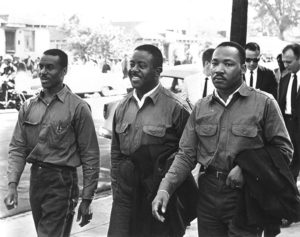
“What would be the verdict of the country about a man who had encouraged hundreds of people to make a stunning sacrifice and then excused himself?” he later recalled. Then he whispered to himself, “I must go.”
It was a turning point in the civil rights movement because King’s jailing helped the movement gain national support. It also moved King to write his famous letter from the Birmingham jail that asked black Americans, despite peaceful demonstrations all over the country, to move outside legal channels to create crisis situations. In response, black protests increased, leading to more than 3,000 jailings by May 1963. Soon, school children would join the marchers, intensifying the movement—and making the movement national instead of only regional.
This letter is long and contains complex academic language. It is probably best to highlight key terms for students ahead of time, or to encourage them to talk about small sections of the letter with a partner. This will happen naturally as you work with students to analyze the argument he presents, but reading it ahead of time will help their comprehension of the letter and the main points made by King.
Read the Letter From Birmingham Jail >>
Delivered at the Cory Methodist Church in Cleveland, Ohio, on April 3, 1964, Malcolm X’s The Ballot or the Bullet speech marked both a turning point in his life as an African American activist and a turning point in the civil rights movement of the 1960s. Malcolm X had recently separated from the Nation of Islam—the black, nationalist, religious organization that advocated separatist and “back to Africa” movements, and for which he had served for almost a decade. In asking the hard-hitting question—ballots or bullets?—people were going to have to bring about social change by either electing the right people to be lawmakers, or they were going to have to take matters into their own hands and, possibly, have a violent overthrow of the current political system. Malcolm distanced himself from the Nation of Islam while defending black self-defense by any available means.
Activities
The speech was especially poignant because President John F. Kennedy had sent a civil rights bill to Congress in June 1963 that had stalled in the House of Representatives, but then passed in February 1964, three months after JFK’s assassination and President Lyndon Johnson’s support of the bill. Yet the bill faced heavy opposition in the Senate from Southern Democrats, most of whom were segregationists and opposed to racial equality. It was in this context that Malcolm X’s speech put two alternatives squarely before black and white Americans alike.
Malcolm X also delivered this speech in Detroit, Michigan.
Read The Ballot or the Bullet speech »
Part 1: Letter from Birmingham Jail
Present students with photographs 1023, 1037, 1038, 1050, 1071, and 1076. When looking at all of these as a group, have them describe what they see by answering the following questions.
It was in this setting that King was put into jail. Read additional background on events leading up to and following the arrest »
Photograph 1076 is a photo of King, along with Fred Shuttlesworth and Ralph Abernathy right before their arrest for protesting. King wrote his well-known Letter from Birmingham Jail from his cell.
Have students read the Birmingham jail letter. As students read the letter, have them keep “facts and feelings/questions” notes, writing down new facts and information that they did not know before, and then their feelings and thoughts about these new facts. For example, after reading the first sentence they might write:
Fact: I did not realize Martin Luther King, Jr. wrote the letter to other pastors and clergy who criticized his work.
Feeling: I thought the churches were united; now I realize that segregation was in all areas of society. Were the clergy who wrote the letter to the newspaper white?
These notes allow for students to have writing prompts and opportunities to interact with each other. As they come to class after having read the letter, have them form groups of three or four to talk about four new facts. The letter is quite long, so you may want to divide into sections and just focus on one section at a time.
After the students have had a chance to debrief with each other, ask them to determine what King’s main concern or claim was in the letter. If students are aware of the components of a well-written argument, then have them identify evidence and warrants that he used to support his claim. Each group should be able to tell the class what they determined was King’s claim and what evidence was used for support. Assess students on the evidence they gather from analyzing King’s letter that supports their claim.
Malcolm X presented a different approach to attaining civil rights than Martin Luther King, Jr. Have students look at a grouping of photos representing struggles African Americans and others who sought an expansion of their civil rights, and photos of resistance to an expansion of civil rights (photographs 1023, 1050,1057, 1071) and attempt to identify emotion and passion in the photographs. This is also an opportunity to have students share how the photographs illustrate strategies of civil disobedience. Photograph 1071 in particular will allow for a fruitful class discussion about strategies.
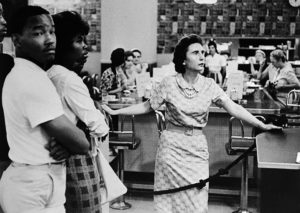
Some suggest that non-violent protests required too much waiting, and that Malcolm X pushed for a more aggressive approach. Evidence of this is his speech called the The Ballot or the Bullet. The speech is long, so provide students with a transcript of the words. As a speech, however, this text was intended to be listened to (as opposed to the King letter, which was intended to be read). Ideally, students should listen to Malcolm X deliver the speech. As they do, have them write down “facts and feelings/questions” from the speech, as they did with the Birmingham letter. After completing the speech, have them form groups and share what they wrote down. Again, due to length, you may want to divide it into segments, and then have the students examine each segment.
After the students have debriefed about the speech, have them identify the key claims that Malcolm X is making and the evidence he used to support his claim.
The civil rights era in the 1950s, 1960s, and 1970s receives a lot of attention as being a time when citizens stood up for equality. It can be misleading, however, to think that this was the only time Americans sought civil rights. Throughout American history, people have attempted to increase the freedoms and rights of oppressed groups, and this continues today.
The Civil Rights Era is also miscast as a time when only African Americans were seeking civil rights. Many different ethnic groups were battling racism, prejudice, and oppression. Women, too, were seeking more opportunities and civil rights. A first wave of feminism in the late-nineteenth and early-twentieth century had fought for and gained, among other things, suffrage—the right to vote—for women. The women’s movement in the mid-twentieth century in the United States is sometimes seen as an outgrowth of the African American movement for civil rights. Existing societal conditions that institutionalized inequality of the sexes provided the impetus for a new awareness of sexism, however. In the 1950s and 1960s, growing numbers of women earned college degrees and entered the workforce. Women earned only 25 percent of all bachelor of arts degrees in 1950; in 1970, this was up to 41 percent. (By comparison, in 2010, about 54 percent of BAs were awarded to women). Numbers of women in the workforce steadily rose in these decades as well; however, women did not get equal pay. Additionally, women, traditionally considered responsible for the domestic realm, were impacted to a greater extent than were men by the lack of resources, such as daycare centers, for working parents.
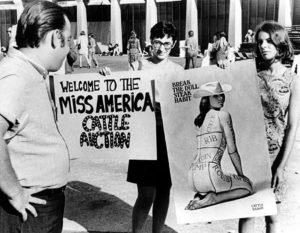
The Civil Rights Act of 1964 made discrimination on the basis of gender unlawful, giving women’s rights activists legal footing to seek change. Just as African Americans had done (and continued to do), women’s groups formed to bring the issue of gender inequality to the public’s attention. One such group was the National Organization for Women, or NOW, started in 1968 by a small group of professional women, including Betty Friedan, author of the 1963 book The Feminine Mystique. NOW declared “…women, first and foremost, are human beings, who, like all other people in our society, must have a chance to develop their fullest human potential.”
In the 1960s and 1970s, the so-called “Second-Wave Feminists” staged protests, employing civil disobedience to attack, among other things, mass media’s portrayal of women and events such as beauty pageants. In 1968, feminists protested the Miss America pageant in Atlantic City, burning bras and copies of Playboy magazine, and nominating a sheep for Miss America. Show photograph 1065 to help provide a context of how these protests appeared in pictures.
The women’s movement helped initiate a societal shift toward gender equality. The 1970s brought legal gains for women, including passage of Title IX of the Education Amendments. Educational institutions and activities, such as sports, that received money from the federal government were now barred from gender discrimination. Other reforms were more difficult to achieve. Though many women and men worked for passage of an Equal Rights Amendment to the U.S. Constitution to ensure full political, social, and economic equality, the ERA was not ratified by enough states to become law. Like other movements for societal change, the women’s movement met resistance from those who believed women should maintain traditional roles.
Read the NOW Statement of Purpose »
With this background information, have students look at photograph 1065 and describe what they see. Then have them look at photograph 1030. In pairs, have the students suggest why someone would have made a poster with a women’s body marked like this. This is an example of using a photograph as the basis for a political poster. The photographer has added text to make a provocative photograph about women’s roles in society. Consider asking pairs of students to talk about the following questions:
Prompt them to use examples from the background on the women’s movement to support their answers. Show the photographs and ask students to compare and contrast the photographs with Martin Luther King, Jr. How did these two forms of civil disobedience seem the same and different?
With this as background and context, have the students refer to the NOW Statement of Purpose. (Students may have read this the night before, or students might read it in class.) Have students refer to the statement as they record answers to the following questions:
After the students have read the statement and answered these questions, have them consider whether NOW is successful today. Does NOW still have relevance today? What should the series of “we believe” statements be for today? Are they still appropriate, or should they be updated? Students can be assessed for how well they support their statements with current examples, facts, and evidence.
Return to photograph 1065, and ask students to come up with a political poster that would help communicate the “women’s movement” at this time. What would the photograph depict? What words would be added to the photograph and why?
Alcatraz Island in San Francisco Bay served as a federal prison from 1934 until 1963. After closing the prison, Alcatraz was deemed to be “surplus” federal land and abandoned for a time. On November 20, 1969, 89 Native Americans—mostly students from colleges and universities in San Francisco and Los Angeles—announced they were taking over the island, and began what would become a 19-month occupation; the longest occupation of a federal facility by Native Americans.
In actuality, the participants likely never intended to live on Alcatraz long term. Although this event was designed to highlight issues concerning Native Americans, it is now viewed as a monumental protest that inspired activism for Native American rights across the country. During the 1940s and ’50s, Native American activism against the U.S. government was generally organized and executed by specific tribes and nations and focused on a specific issue, such as fishing rights or other treaty rights violations. The tone of the activism sweeping the nation in the 1960s, however, may have helped promote a more attention-grabbing action: The occupation of Alcatraz inspired Native Americans across the country to rally together.
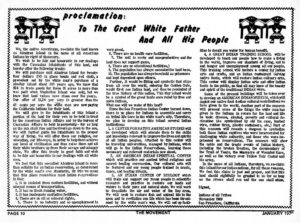
To announce their action to the nation, occupiers issued the Alcatraz Proclamation. Because the Native Americans were from many native populations (Sioux, Blackfoot, Apache, Navajo, Cheyenne, and Iroquois), the Proclamation was signed by “Indians of all Tribes.”
The Proclamation had a half-serious style: Its statements were meant to give insight. The inhabitants made hand-painted signs with sayings such as “You Are on Indian Land,” “Red Power,” and “Human Rights, Free the Indians.” This movement called to action Native Americans who would occupy other federal lands in the coming months. As one Native American activist stated: “Then there was that spark at Alcatraz, and we took off. Man, we took a ride across this country. We put Indians and Indian rights smack dab in the middle of the public consciousness for the first time since the so-called Indian Wars” (Russell Means, Oglala Lakota). Read Russell Means’s full quotation, and get background information »
Read a full transcript of the Alcatraz Proclamation »
With this background information, have students look at photographs 1061, 1064,1073, and 1074, and describe what they see.
Note: Photo 1061 is of the Declaration (May 1970) written on cowhide after the Proclamation (November 1969).
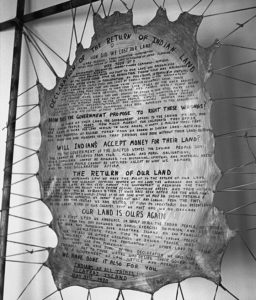
Download a transcript of The Declaration (PDF)
In pairs, have students share answers to the following questions:
As a class, look at copies of photograph 1061. This is a picture of the Alcatraz Declaration. Ask students to describe how the Declaration was presented, what they notice about the material on which it is printed, or if anything else stands out as being noticeable in the photograph.
Turning to the Proclamation text, have the students read along as you read to them the Proclamation. Focusing on “voice,” ask the students to share how they would describe the tone of the writing. For example: Was it funny? Was it sarcastic? Was it confrontational? What evidence can they pull from the text that would support their opinion about the tone?
In groups of four, have the students read the Alcatraz Proclamation again and specify what they think the protesters were demanding. What was the main argument they were making? What historical examples did the writers use to explain the reason for occupying Alcatraz Island? When supporting a claim, what evidence is used to support the claims made in the Proclamation?
Finally, in these same groups of four, have students research one of the following topics mentioned in the Proclamation. Their research could be done in class, and should result in a short paragraph description of the topic:
After each group has found a suitable answer, “jigsaw” them by forming new groups that have one member from each question group. In this way, the new groups will have at least one student for each of the questions, and they can share their answers with the other group members.
Note: In a class of 32 students, you will have eight groups of 4; each group will research two questions. After sharing with the groups, have the class discuss whether the occupation was a success.
Argument is a structured approach of appealing to logic. According to the Common Core State Standards for English/Language Arts, “the ability to write logical arguments based on substantive claims, sound reasoning, and relevant evidence is a cornerstone of the writing standards, with opinion writing—a basic form of argument—extending down into the earliest grades.”[2] In groups of three or four, have the students select one of the four texts and evaluate it on the following criteria:
Student groups will need a substantial amount of time to think about this topic, and you may want to set aside class time for this. One idea would be for all the student groups to examine the same argument together. Or, you could divide the groups so that each of the four arguments is examined, and then a class discussion about the merits of each can be held as a concluding activity. Of course, the Letter from Birmingham Jail and the The Ballot or the Bullet speech will require more time for this evaluation activity than the NOW statement or the ARPM proclamation, so you will want to plan accordingly. Students could also select one photograph that they think would be a compelling “icon” for this argument, and provide an explanation why this “iconic photograph” is a good choice.
Additionally, and as a further extension of their learning from these texts, have the students answer these two questions:
The segregated public school system in the 1950s and 1960s revealed deep-rooted racism in America—racism that went far beyond the schools. The photographs from Little Rock, Boston, and Los Angeles intended to establish that seeking civil liberties was not just a series of events by African Americans in the South. When moving to the literature, four very different texts allowed for a look at using argument to seek freedom from oppression. The letter from King, the speech by Malcolm X, the statement by NOW, and the Proclamation by ARPM each have claims, warrants, and evidence. They argue for improvements to the current state of freedom of civil rights. These groups and countless others still seek freedom and equality in United States. These four texts are case studies from which students might inquire into other groups’ approaches for seeking civil rights. Photographs provide powerful imagery of place, context, and setting. Photographs, primary source texts, and background information all help provide for a cognitive and sensory engagement with this historical period of America.